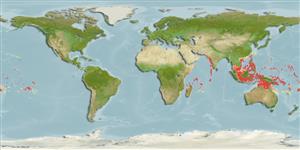Environment: milieu / climate zone / depth range / distribution range
Ecologie
marien demersaal; diepte 1 - 82 m (Ref. 26267). Tropical
Western Pacific Ocean: Indonesia.
Grootte / Gewicht / Leeftijd
Maturity: Lm ? range ? - ? cm
Max length : 7.1 cm TL mannelijk / geslacht onbekend; (Ref. 26267)
Dorsale zachte stralen (totaal) : 87; Anale zachte stralen: 73; Wervels: 48. This species is distinguished from all congeners by the combination of: ID pattern1-2-2-2-2; caudal-fin rays 12; vertebrae; 9 (3 + 6) abdominal, 48 total; hypurals 4; D 87, A 73; longitudinal scale rows 64; transverse scale rows 25; scale rows on the head posterior to the lower orbit 15; body elongate (BD = 24.9% of SL); preanal length long (PAL = 28.1% of SL); upper head lobe much smaller than lower lobe; head long (HL = 24.2% of SL), longer than head width (HW/HL = 0.97); postorbital length long (POL = 76.5% of HL); snout short (SNL = 10.4% of HL, SNL/ED = 1.25), slightly rounded anteriorly; dorsal-fin origin located at the vertical posterior to upper eye; predorsal length short (PDL = 18.1% of HL); eye is relatively small (ED = 8.4% of HL); eyes are unequal in position with anterior margin of upper eye greatly in advance of anterior margin of lower eye; fleshy ridge well developed on posterior part of ocular-side lower jaw; membrane covering upper and lower eyes; with continuous, fleshy membrane connecting anterior nostril with lower part of eye. Colouration: ocular-side pigmentation uniformly yellowish-brown; blind-side pigmentation uniformly yellow; both sides with obvious dermal spots on bases of anteriormost dorsal and anal fins (Ref. 126065).
Presumably frequents coastal lagoons with sandy bottom. More studies are needed concerning the ecology of this species.
Levenscyclus en paargedrag
Maturities | Voortplanting | Spawnings | Egg(s) | Fecundities | Larven
Munroe, T.A. and B.N. Marsh, 1997. Taxonomic status of three nominal species of Indo-Pacific symphurine tonguefishes (Symphurus: Cynoglossidae: Pleuronectiformes). Ichthyol. Res. 44(2):189-200. (Ref. 26267)
Status op de Rode Lijst van het IUCN (Ref. 130435)
Gevaar voor de mens
Harmless
Gebruik door de mens
Visserij: van geen belang
Tools
Speciale rapporten
Download XML
Internetbronnen
Estimates based on models
Preferred temperature (Ref.
123201): 26.1 - 29, mean 28.2 °C (based on 1024 cells).
Fylogenetische diversiteitsindex (Ref.
82804): PD
50 = 0.5000 [Uniqueness, from 0.5 = low to 2.0 = high].
Bayesian length-weight: a=0.01000 (0.00244 - 0.04107), b=3.04 (2.81 - 3.27), in cm total length, based on all LWR estimates for this body shape (Ref.
93245).
Trofisch niveau (Ref.
69278): 3.2 ±0.4 se; based on size and trophs of closest relatives
Weerstandsvermogen (Ref.
120179): Hoog, minimale populatieverdubbelingstijd minder dan 15 maanden (Preliminary K or Fecundity.).
Fishing Vulnerability (Ref.
59153): Low vulnerability (10 of 100).
